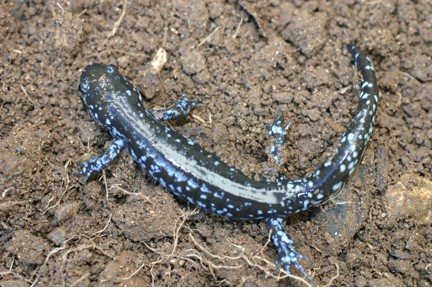Home -
Reptiles and Amphibians -
Salamanders

Blue-Spotted Salamander at Kuse Nature Preserve
Salamanders
Blue-Spotted Salamander
Ambystoma laterale
The Blue-spotted Salamander, a slender blue-blacked animal with whitish or blue spots on its back, is sometimes found under logs, rocks, leaf litter or even in a basement. It has twelve to fourteen grooves on the side of its body. It eats earthworms and insects.
Salamanders hibernate in soil below the frost line. In spring they emerge to migrate to breeding ponds where the females may lay about 200 eggs attached singly or in small numbers to plant material. The eggs hatch in about three to four weeks and the larvae metamorphose into adult salamanders in about two to three months.
Because they breed in temporary or vernal woodland ponds, clear cutting and other logging operations have destroyed some of their habitat. Logging operations may cross the migration routes and kill numerous salamanders.
Description
|
Relationships
|
Activities
|
|
|
|
|
